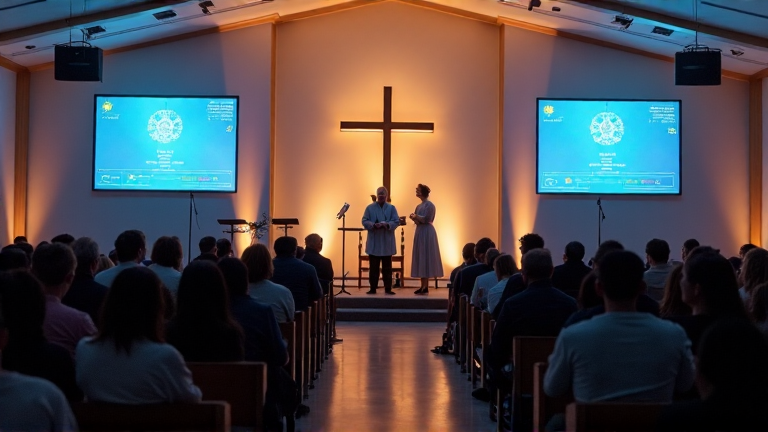
Pastors in the Age of AI: 3 Essential Conversations for Ministry
Artificial Intelligence (AI) conjures images of futuristic scenarios and cautionary tales of a technocratic takeover. The term itself was popularized at the Dartmouth Conference in 1956 by John McCarthy, who deliberately selected a dramatic label to describe a multitude of related but distinct technologies. Today, AI touches nearly every facet of life, from social media prompts to banking notifications—illustrating how deeply integrated machine learning has become in society.
Ewa Luger defines AI as the capacity of a computational system—whether a digital computer or a robotic entity—to execute tasks typically associated with human intelligence. This duality of promise and risk makes AI especially pertinent for communities of faith. The implications of AI are far-reaching, affecting both the broader world and intimate religious communities, marking a transformation as significant as that introduced by the internet and email.
In light of these advances, pastors are encouraged to engage in three pivotal discussions, both within their ministry teams and among their congregations, to transition from sensationalism towards a reflective and thoughtful approach that minimizes unexpected challenges and addresses the concerns of believers.
1. Should AI Be Utilized in Ministry—and If So, How?
A striking demonstration of AI's impact occurred in 2023 during a forty-minute worship service in Fürth, Germany, where ChatGPT, represented as a middle-aged figure on a screen, led the service at the biannual Deutscher Evangelischer Kirchentag. This experiment, envisioned by Jonas Simmerlein of the University of Vienna, was received with unexpected ease despite its novelty.
However, the temptation to over-rely on AI is not new. Pastors have long wrestled with borrowing sermons or adopting flashy yet misleading illustrations. Today, AI exacerbates these tendencies by offering expedited access to content that could tempt busy ministers to replace hours of thought with minutes of digital production. The timeless lesson echoed in Jurassic Park—"Just because humans can create something doesn’t mean they should"—resonates with the biblical narrative of the Tower of Babel. Here, the focus is on human ingenuity as an element of divine design, rather than on the specific technologies employed.
This raises important questions regarding the appropriateness, timing, and methods of integrating AI into pastoral work, as well as what it truly means for a minister to operate under the inspiration of the Holy Spirit.
2. Exploring Today's Possibilities and Pitfalls of AI
Modern AI offers valuable tools that can streamline routine tasks, effectively providing pastors with a virtual assistant or 'copilot'. Various ministry blogs already illustrate practical applications such as targeted outreach initiatives, virtual assistance for event planning, and support for discipleship groups. Two current examples highlight both the promise and the dangers:
A. Midjourney
Midjourney has revolutionized how ministries craft visual aids. Previously, creating compelling visuals for sermons could mean scavenging the internet for suitable images. In contrast, Midjourney allows a pastor to simply describe the desired image and receive a customized piece of art within minutes. Despite its efficiency, critics argue that Midjourney does not 'create' in the human sense but rather amalgamates existing artwork using deep learning techniques—which some equate to mimicking or even appropriating creative work. This raises ethical questions similar to those surrounding the use of AI in sermon preparation.
B. Perplexity
In a demonstration of AI’s current capabilities, Perplexity AI was asked to identify the three most essential insights for pastors concerning AI. The response was as follows:
- AI can streamline administrative tasks, freeing time for interpersonal ministry and personal reflection.
- AI enables pastors to bridge cultural gaps and broaden their outreach.
- AI assists with research in biblical literature, providing ideas and sermon outlines.
While accurate, these answers are compilations of readily available information, underscoring that today’s AI often mirrors standard research tools rather than offering fresh insights—hinting at a more transformative potential in the future.
3. Preparing for the AI of Tomorrow
The rapid evolution of AI suggests that its impact on ministry is poised to expand dramatically. To navigate this evolving landscape, pastors are recommended to open three lines of dialogue with their congregations:
A. Transparency
Open discussion about the use and extent of AI in ministry fosters trust and demystifies its role, mitigating fears and preempting potential accusations of deception.
B. Boundaries
Explicitly communicating technology usage policies—especially in relation to family and personal time—helps set standards for ethical behavior. This dialogue can extend from familiar issues like smartphone usage to broader theological questions regarding the integration of tech and faith.
C. Teaching
Instead of relegating technology to a cautionary tale, pastors can devote sermons or elective classes to explore how technology coexists with humanity, drawing on biblical narratives even when direct references to modern technology are absent. This approach offers a balanced perspective that acknowledges both the benefits and challenges of rapid digital advancements.
Conclusion
As AI continues to evolve, its integration into ministry will demand a delicate balance of ethical reflection and practical adoption. By embracing transparent practices, establishing clear boundaries, and fostering open educational dialogs, church leaders can harness AI’s potential while safeguarding the values and integrity of their spiritual communities.
Note: This publication was rewritten using AI. The content was based on the original source linked above.